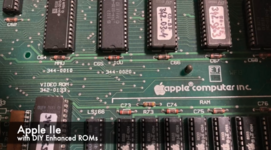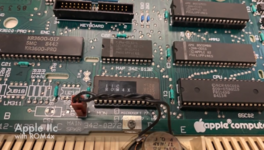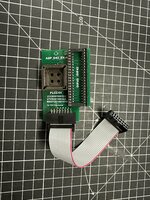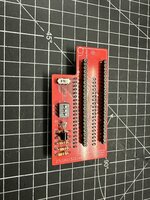@retr01
Kay does make a good point. And he has kindly given me that same advice in the past too. I certainly do not want to discount the important of his recommendation at all. Even so, I will share my story below and then provide you with your two options.
MY STORY
I ultimately broke down and bought
this T48 kit in May 2024, in large part because I wanted to help out a fellow vintage computer enthusiast in need. That person asked if I could
desolder an EPROM from my rather rare MMI 10MB HDD (from my HyperDrive kit) and extract its contents. Ultimately, I turned a blind eye to the high risk of accidentally destroying the drive, in large part because I decided my action would help not only that one person but the community at large too (by way of sharing the file). The ROM dump I made using the T48 is now a
Resource here.
Of course, the T48
cannot be used with a Mac

, and I didn't want to
eat drive space with Virtualization. And to avoid tainting myself with a PeeSee (correct spelling) at home, I just borrowed one at the office. It runs Windoze (proper spelling) version 8, and the T48 software runs fine on it. The T48 software is reasonably easy to use, at least for me it was, but I have experience programming PIC MCUs using Microchips software (which actually DOES work on Macs), so maybe that's why.
Folks who can't borrow a Bill Gates Abomination at the workplace may have no choice but to go with Virtualization; and honestly, there's nothing wrong with it if you've got the drive space on your modern Mac for it. (I actually do, but I'm stingy with my drive space.)
In terms of purchasing low-cost tech on the Dark Side, you probably could opt to buy a cheap "netbook" for the sake of keeping the size small, allowing you to then hide it easily when not in use. You can't easily hide away a large desktop PC.
I don't mean to tick off the Windows lovers too much. I deliberately poke fun at the PC world because I've always felt Windows to be little more than a bad copy of macOS, and I've been perpetually surprised at how >72% of the planet is addicted to that platform. I've used other people's Windows machines enough to know it's not great. Heck, I even built Windows PCs when I was a senior in high school in 1989, and our electronics class was also tasked with maintaining them too! Yeah, they've made a lot of advances since 1989, but I still feel icky using even Windows 11.
Beyond that, my first home computer was the 128K Mac in 1984 when I was 13. Since that time (for the last 40 years), I've never purchased a Windows PC for my personal home use, nor even ever brought one home. I kid you not. Not being a gamer helps avoid the PC world, I guess. Some may call my never having owned a PC crazy, but others would regard it as genius.
END STORY
You have
2 hardware choices on how to flash your SMC ROM SIMM:
1. Buy a cheap PC or use Virtualization so you can use a T48 programmer to flash the individual chips on the SMC ROM SIMM, in conjunction with the four BIN files that the Crucible app generates.
or
2. Buy a
ROMmate Programmer v2 (BMOW no longer makes their
ROM-inator programmer), then use the
v2.0 SIMM Programmer app from
@dougg3 (Downtown Doug Brown). Even though you don’t have to use the
Crucible v1.1 app anymore with this setup, what’s really neat is that you can still use it, if you want, to change your little Happy Mac icon to something else, then export the four BIN files. Doug’s v2.0 SIMM Programmer app is able to easily flash those 4 BIN files to the individual chips on your
2MB SMC ROM SIMM while the ROM SIMM is socketed in a v2 ROMmate Programmer. You don’t even have to pull out the chips from the SMC ROM SIMM, which makes flashing fast and convenient. On top of that, this setup can flash all of the flashable SE/30 ROM SIMMs sold today (Kero's Mac Mods, GGLabs, BMOW, SiliconInsider, CayMac Vintage, Garrett's Workshop, etc.). So if you have more than one ROM SIMM from different vendors, Choice-2 is really the ultimate choice.




